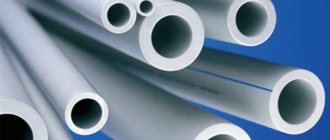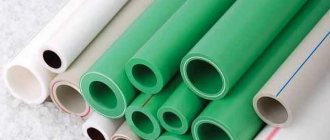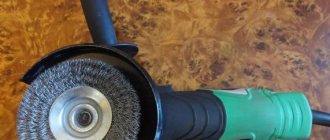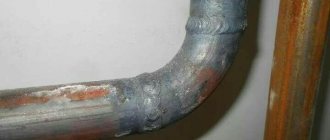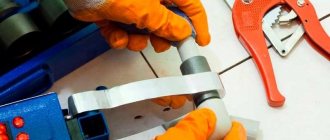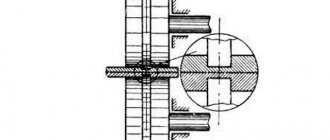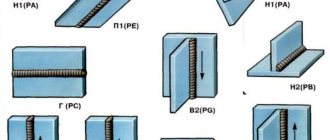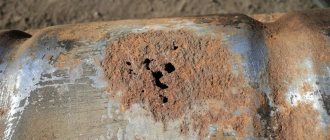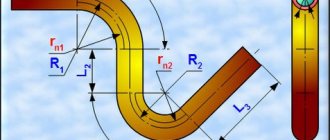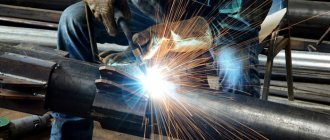When setting off on a long journey, a motorist must think through many details that, to one degree or another, can make the journey easier. One of the points that needs planning is purchasing a special repair kit. It is necessary to troubleshoot problems that arise on the road (broken gas tank, radiator, cracks in the muffler, body, and much more). An invariable component of such a kit is cold welding. It should be noted that it is also useful when carrying out plumbing work and will simply help out in difficult everyday situations. You can use it to work with metal surfaces, plastic, concrete, linoleum, restore a broken earthenware sink and a ceramic vase (decorative or food vase is strictly prohibited). The main advantage of this method is that it does not require special skills or complex equipment.
About cold welding
Cold welding is a complex concept that refers to 2 completely different processes:
- Applying pressure to metal surfaces. As a result, plastic deformation occurs in the compression region followed by bonding.
- Connection using a hardening compound. The most popular and in demand method, actively used at home and in production.
The latter method enjoys well-deserved popularity due to its ease of use and low temperature requirements. Gluing is carried out using a special substance that is applied to certain parts. The welding compound penetrates into the upper layers. Manipulations are carried out under pressure.
Plastic deformation affects the upper layers, usually covered with an oxide layer. As a result, the distance between the parts requiring gluing becomes as close as possible. The crystal lattices are practically connected. In other words, a chemical reaction occurs.
The term refers to a special adhesive containing additives that increase strength characteristics. Application is carried out in a continuous line or dotted. The plastic mass polymerizes and hardens. The method is indispensable for restoring damaged parts, sealing cracks and eliminating formed holes.
Compound
The adhesive mass, which has increased elasticity, provides a strong connection even in hard-to-reach places. It can be one- or two-component. The composition is influenced by the purpose and manufacturer. As a rule, it is kept secret, as it is a trade secret. The variability of components is reflected in the hardening time, operating temperature and area of use. The result obtained is influenced by the composition, proportions, correct application, compliance with the instructions and operating standards of the finished product.
Cold welding consists of:
- Epoxy resin. The basis that gives the substance stickiness, homogeneity and plasticity.
- Metal powder (iron, steel, copper, cast iron, aluminum). The filler increases strength and thermal conductivity.
- Plasticizer. It is polyethylene polyamine or amine hardener. It reacts chemically with the epoxy resin and triggers crystallization. Gives greater plasticity and resistance to mechanical stress.
Depending on the number of components, it happens:
- One-component. Suitable for one-time use. Since after opening it gradually loses its qualities.
- Two-component. Retains its qualities for a long time after depressurization of the packaging. The adhesive properties remain unchanged.
The goods are delivered to the shelves:
- in a bulk plastic flask, divided into 2 parts: the weld is stored in a cylindrical tube, a hardener is placed on top, covering the epoxy resin mixed with metal particles.
- in 2 separate tubes.
Regardless of the method of distribution, the components are mixed immediately before use.
What temperature can it withstand?
The maximum permissible value at which the seam will maintain its integrity depends on it. The characteristics depend on the composition used. Manufacturers indicate all the necessary data on the packaging.
For budget cold welding, the temperature is 260C. But in order for the substance to fully open, it must be applied correctly. Otherwise, peak strength will not be achieved. The compositions are relevant for the repair of parts operating in normal temperature conditions.
High-temperature compositions do not lose their properties at significantly higher rates. They are in demand for joining surfaces exposed to extreme heat. In such cases, the use of traditional welding is problematic.
In what cases should you give preference?
Compositions for metals are manufactured in accordance with GOST 2601-74. With their help, structures are not only repaired, but also created.
Using instead of electric arc welding is relevant if:
- there is a risk of surface deformation;
- when significant stress occurs;
- The workpiece is large and heavy.
What is strictly forbidden to repair?
- Cast iron pipes and heating radiators. Because due to the difference in the expansion coefficient of the base and glue, cracks and chips form, leading to peeling. Repairs are allowed only in case of emergency, until the problem is completely resolved in the near future.
- Restoration of metal, ceramic and plastic utensils used for eating. High toxicity will negatively affect health.
- Repair and connection of drinking water pipes. An exception may be made in case of emergency, but subject to replacement in the near future.
Where is it applicable?
Cold welding has rapidly gained popularity. The solution is in demand in many areas of activity.
- Repair and restoration of water supply plastic pipes.
- Laying linoleum. Allows you to eliminate joints. The color of the finishing material remains unchanged.
- Car maintenance. Bonding of torn or broken metal parts, restoration of radiators, mufflers, crankcases, sump, fuel tank, etc. The key feature is that during restoration there is no need to drain gasoline, diesel fuel, or oil. It does not react and hardens in a matter of minutes. Economical consumption allows long-term use.
- Bonding metal surfaces that conduct electrical voltage (provided the power supply is turned off during the work).
- Interaction with any plastic elements except polyethylene. Processing is allowed provided that the product is not under pressure or at high temperatures.
- A combination of ceramics, tiles, stone and glass. Almost any variation of components is possible. Broken bowls, vases and other ceramic objects are no longer a problem, since the adhesive composition restores them without problems. After processing, the seam is almost invisible.
- Fixation of floor finishing materials (linoleum, carpet).
- Repair of furniture, home furnishings and tools.
- In the production of household appliances.
- Electrical industry.
- For connecting aluminum and copper wires.
Why is it in demand on the market?
The technique enjoys well-deserved popularity. Before joining those who have already appreciated this method, it is recommended that you familiarize yourself with the strengths and weaknesses. This will help you make your final decision.
Advantages:
- no need to purchase special equipment;
- does not require special skills;
- it will not be difficult to purchase at the nearest supermarket;
- products are not deformed due to exposure to high temperatures;
- strong seam;
- it is allowed to carry out activities in fire and explosive conditions;
- sealing of cases and containers that cannot be heated;
- It is allowed to weld electrical wires without stripping the insulation;
- environmentally friendly process (no gas, smoke, etc. is emitted);
- zero energy costs;
- carrying out repair work under water;
- connection is possible without dismantling parts;
- high speed;
- you don’t need to put in a lot of effort;
- heat-resistant compounds that can withstand temperatures above 1000C.
Flaws:
- not the best solution for large-scale work;
- The strength of the seam is lower than analogues obtained in the usual way. In this regard, it is impossible to use in industry;
- to obtain an effective result, it is necessary to thoroughly clean the surfaces;
- after hardening, the glue may become brittle;
- the resulting seam needs further processing.
What happens?
Cold welding, created on the basis of epoxy resin, is a worthy competitor to the usual method. It comes to the rescue in cases where it is not possible to use the usual one due to various reasons. The only thing to keep in mind is the inferior strength of the seam.
The composition affects the quality of the connection and state of aggregation.
- Liquid. The kit includes an epoxy resin solution with filler and a hardener. Individually, the components are inert and can be stored for a long time. Before use, squeeze out the required amount of mass in a 1:1 ratio. The resulting mixture is applied to the workpiece according to the instructions,
- In the form of a bar. Outwardly, it is practically indistinguishable from children's plasticine. Depending on the composition, the bar or cylinder can have one or two layers. The upper part received a darker layer (epoxy resin). The core consists of hardener and metal dust. The latter increases strength and resistance to temperature and mechanical stress. Cut off the required amount from the mass and knead thoroughly with your hands, adding a little water. Mash for 5 minutes. Then applied to the surface. The mass quickly loses its plasticity. Therefore, gluing should be done as quickly and accurately as possible.
According to the method of connection they are divided:
- Spot. To close a small hole (eliminate a leak in a pipe).
- Suture. The mass is applied along the entire length of the crack, completely covering it.
- Butt. To connect two parts.
- Tavrovaya. Glues brass pins and busbars of electric locomotives.
- Shear welding. Suitable for water supply pipes, heating systems, and railway transmission lines.
The choice of glue is determined by the composition and specification. The range covers almost all spheres of human life. Depending on the intended purpose, there are:
- Universal. Can be used to work with almost all materials. Has the lowest strength. Withstands temperatures up to 260C. Designed for gluing polymers, ceramics, wood, metal, plastic. They interact with metal only in cases where it is not used in harsh conditions. They act as an indispensable assistant in the household.
- Working underwater. Two-component moisture-resistant compounds are in demand among plumbers. The product is applied directly to the leaking pipe. Available in liquid and semi-liquid form.
- Automotive. Cracks, through holes and leaks are well known to every vehicle owner. To solve such problems, the compositions must be resistant to oxidizing agents, temperature changes, and vibration. The tensile strength is at least 200 newton. Bar welding completely fills the resulting deformation.
- For metal (cast iron, aluminum, etc.). The composition contains a certain filler that reliably connects almost all types of surfaces.
- Concrete. The group received increased bonding qualities. This is due to high hygroscopicity and dust generation. They resort to its help when restoring monuments, statues, products and, if necessary, securing something without resorting to drilling.
How to choose?
- Decide on the purpose. The welding must be appropriate for the material being exposed. Otherwise problems may arise. As a last resort, it is possible to use glue with a metal core.
- Permissible temperatures. If the part is exposed to prolonged heat or is under an open flame, it is necessary to purchase appropriate compounds.
- How quickly it dries. If there is a need for urgent repairs, it is recommended to have 2 types on hand. First use welding and allow it to dry for an hour. This will help solve the problem. But since the layer does not have high strength, apply a long-drying compound (24 hours) on top.
- How to remove. To do this, use solvents or acetylene. The liquid is carefully treated with the frozen substance and lifted by the edge. This can damage the finish, especially wood and glass. Therefore, it is necessary to be extremely careful when using cold welding.
Advantages and disadvantages
Many people choose to work with liquid welding because it has many advantages. And it is true. Among the main ones are:
- Low price and availability.
- The weld dries quickly.
- Suitable for joining many surfaces.
- More reliable than many glues (for example, “Moment”).
- After completion of work, repaired products may come into contact with food.
- The finished work looks aesthetically pleasing.
- Welding retains its properties in the cold.
- The cost of the product is justified by the characteristics.
- No welding machine required for use.
- No special tools are needed for the job.
- The work is carried out without the use of electrical media.
- No material waste.
- Lack of heating (connection as in space) and, as a result, better aesthetics.
- Possibility of repairing containers that contain explosive or flammable substances.
Among the disadvantages of cold welding, it is difficult to single out particularly serious ones. If you use the product only for its intended purpose and according to the manufacturer's recommendations, there will be no problems with its use.
How to work?
- The application site is thoroughly cleaned and degreased. The surface will become rough after using coarse sandpaper.
- To prevent the composition from sticking to your hands, it is recommended to moisten them with water.
- Before starting work, carefully study the instructions. Pay special attention to the temperature conditions and drying time of the glue.
- Squeeze the substance into a prepared container in a 1:1 ratio. Mix until the mixture is homogeneous in color and viscosity.
- Cover both surfaces to be treated with glue and press. Remove excess with a cloth soaked in acetone.
- The part should be at rest for 5 to 60 minutes (primary drying time).
- The product will dry completely in 12 - 24 hours.
An example of the use of cold welding is in the video:
Preparing the work surface
Carrying out any cold welding work begins with surface preparation. A wet surface must be wiped to remove any moisture. The best treatment for any surface is done using a degreaser or acetone. It will help dissolve any fat. A dry surface holds liquid welding many times better than one with moisture. Dust, debris and any contaminants should also be removed from the surface.
If desired or necessary, the surfaces to be joined should be cleaned with sandpaper. If this happens, dust removal and degreasing should be repeated.
ADVICE! This measure is necessary to connect perfectly smooth surfaces so that they become slightly rough. The sandpaper should be coarse - number 40-100.
The best budget cold welding adhesives
Poxipol 00266 0.014 l
The product is classified as universal. Two-component glue will become an indispensable helper at home. Glues almost all available materials. Withstands temperatures from -50 to +120°C. When frozen, it retains its elasticity. Can be used underwater. Resistant to acids, solvents and aggressive chemicals.
Poxipol 00266 0.014 l
Advantages:
- comfortable application;
- sets quickly;
- does not change properties over time;
- does not rust;
- not deformed.
Flaws:
- small volume.
Second 403-203 0.075 l
Universal liquid installation is focused on working with solid PVC material and ABS plastic. Can be used indoors and outdoors. Organically fills cracks and holes in any material. Creates a transparent, waterproof elastic seam. It will take 6 hours to dry completely.
Second 403-203 0.075 l
Advantages:
- strong seam;
- elastic base;
- domestic brand.
Flaws:
- After use, it is necessary to remove air bubbles from the tube, otherwise the glue will quickly thicken.
IMG MG-425 60 g
Designed for joining various types of materials (steel, aluminum, nickel, lead, wood, plastic, porcelain, rubber). Setting time is only 4 minutes. 10 is enough for hardening. Fills voids and cracks inside cast parts. Over time, it does not change characteristics and is not deformed. Resistant to vibrations and mechanical stress.
IMG MG-425 60 g
Advantages:
- does not cause corrosion of metal parts;
- grabs quickly;
- nice price;
- high adhesion to materials.
Flaws:
- noticeable shrinkage;
- At first it smells strong and unpleasant.
Key Features
The use of the material is very simple and does not require welding equipment. This plastic glue is sold (article according to GOST OKPD 2) in a round mini jar, instructions are attached to it. The material hardens in air; it does not need to be provided with a high temperature for hardening.
This product holds not only metals. It can be used to join wood or any other material. High plasticity makes it possible to glue any surface, even those that have a large load. Using liquid welding, you can glue together products from:
- stainless steel;
- ceramics;
- wood;
- become;
- linoleum (for example, Tarkett);
- rubber (PVC);
- copper;
- India;
- polypropylene pipes;
- batteries;
- heating systems and other materials.
IMPORTANT! Although liquid welding is a very strong and reliable material, it is the weakest of all types of welding. If it is possible to work with more reliable joining materials, preference should be given to them.
The best cold welding adhesives in the mid-price segment
PERMATEX Cold Weld 14600 56 g
Adhesive for parts subject to increased load. A universal solution for interaction with ferrous and non-ferrous metals. After polymerization, it forms a hard layer that can be drilled, filed and painted. Thanks to this, it is possible to restore the original appearance.
PERMATEX Cold Weld 14600 56 g
Advantages:
- maximum load for steel 3000 PSI;
- mechanical processing of the seam;
- no need to heat to accelerate polymerization;
- gap filling;
- fire resistant.
Flaws:
- Due to the high speed of hardening, work must be carried out as quickly as possible.
TANGIT EPOXY-LOCK
A new product from the German company Henkel, which needs no introduction. Its products are well known in all corners of the globe. The universal Epoxy-lock flawlessly copes with the task, firmly connecting any type of material. Works well when sealing minor leaks in pipes and heaters. The dried seam can be sanded and further painted to restore its original appearance.
TANGIT EPOXY-LOCK
Advantages:
- for underwater work;
- temperature range from -30 to +150°C;
- does not contain solvents;
- easy application;
- high strength.
Flaws:
- does not glue polyethylene, polypropylene and Teflon;
- takes a long time to set.
Kafuter AB
A universal solution for any type of surface, aimed at home use. A permanent member of the portable repair kit. Distributed in two tubes marked A, B. Initial drying within 1 hour. The components are mixed in proportions 1:1.
Kafuter AB
Advantages:
- universal purpose;
- sealed packaging;
- The optimum ratio of price and quality.
Flaws:
- initially emits a pungent odor.
Types of Hi-Gear compounds
In the review, it is appropriate to consider the features of all compositions of the American manufacturer; you can choose a special Hi-Gear adhesive; fast steel is produced for non-ferrous metals and alloyed alloys.
Hi Gear brand cold welding types:
- universal adhesive with steel filler glues carbon and low-alloy steels, stainless steel, chrome-plated steel, and is used in auto repair shops for minor repairs of spare parts and restoring the integrity of the body;
- cold welding “Superbronze” is intended for copper-containing alloys, creates a decorative bronze effect, contains soft metals, and after hardening the ductility resembles bronze and brass;
- “White titanium” composition is purchased for gluing parts that regularly experience thermal stress. Titanium powder improves the strength properties of the adhesive and increases the heat resistance of the joint.
Types of Cold Welding Hi-Gear
When purchasing cold welding, you must carefully study the label; special compounds differ in packaging color and cost.
The best premium cold welding adhesives
Werner Muller Type A
One-component adhesive originally from Germany is used for joints of PVC floor coverings with a tightly cut overlap seam (type A). The joint obtained in this way is waterproof, durable and almost immediately ready for use. The location of the seam is almost impossible to determine on your own. The steel needle makes application easy. Additional protection of the connection is provided by special paper glue.
Werner Muller Type A
Advantages:
- German quality;
- convenient application of the material;
- reusable;
- can be stored for 3 years.
Flaws:
- narrow specialization.
UHU Repair All Powerkit
Two-component epoxy resin forms an adhesive joint of increased strength. One of the best solutions for repair and installation work. Can be used under water and in rooms with high humidity. The hardening process begins after 2 minutes at room temperature.
UHU Repair All Powerkit
Advantages:
- does not contain solvents;
- does not lose its qualities at temperatures up to +1000 °C;
- high hardening speed;
- German quality.
Flaws:
- volume too small.
